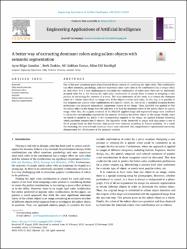| dc.contributor.author | Gündüz, Ayşe Bilge | |
| dc.contributor.author | Taşkın, Berk | |
| dc.contributor.author | Yavuz, Ali Gökhan | |
| dc.contributor.author | Karsligil, Mine Elif | |
| dc.date.accessioned | 2024-04-19T12:24:32Z | |
| dc.date.available | 2024-04-19T12:24:32Z | |
| dc.date.issued | 2021 | en_US |
| dc.identifier.citation | Gündüz, Ayşe B., Taşkın, B., Yavuz, Ali G., Karsligil, Mine E. (2021). A better way of extracting dominant colors using salient objects with semantic segmentation. Engineering Applications of Artificial Intelligence. | en_US |
| dc.identifier.uri | https://www.sciencedirect.com/science/article/pii/S0952197621000518?via%3Dihub | |
| dc.identifier.uri | https://hdl.handle.net/20.500.12846/1078 | |
| dc.description.abstract | One of the most prominent parts of professional design consists of combining the right colors. This combination
can affect emotions, psychology, and user experience since each color in the combination has a unique effect
on each other. It is a very challenging to determine the combination of colors since there are no universally
accepted rules for it. Yet finding the right color combination is crucial when it comes to designing a new
product or decorating the interiors of a room. The main motivation of this study is to extract the dominant
colors of a salient object from an image even if the objects overlap each other. In this way, it is possible to
find frequent and popular color combinations of a specific object. So, first of all, a modified Inception-ResNet
architecture was designed semantically segmentate objects in the image. Then, SALGAN was applied to find
the salient object in the image since the aim here is to find the dominant colors of the salient object in a given
image. After that, the outputs consisted of the SALGAN applied image and segmented image were combined
to obtain the corresponding segment for the purpose of finding the salient object on the image. Finally, since
we aimed to quantize the pixels of the corresponding segment in the image, we applied k-means clustering
which partitions samples into K clusters. The algorithm works iteratively to assign each data point to one of
the K groups based on their features. Data points were clustered according to feature similarity. As a result
the clustering, the most relevant dominant colors were extracted. Our comprehensive experimental survey has
demonstrated the effectiveness of the proposed method. | en_US |
| dc.language.iso | eng | en_US |
| dc.relation.isversionof | 10.1016/j.engappai.2021.104204 | en_US |
| dc.rights | info:eu-repo/semantics/openAccess | en_US |
| dc.subject | Deep neural networks | en_US |
| dc.subject | Dominant colors | en_US |
| dc.subject | k-means clustering | en_US |
| dc.subject | Salient object detection | en_US |
| dc.subject | Semantic segmentation | en_US |
| dc.subject | SALGAN | en_US |
| dc.title | A better way of extracting dominant colors using salient objects with semantic segmentation | en_US |
| dc.type | article | en_US |
| dc.relation.journal | Engineering Applications of Artificial Intelligence | en_US |
| dc.relation.publicationcategory | Makale - Uluslararası Hakemli Dergi - Kurum Öğretim Elemanı | en_US |
| dc.contributor.department | TAÜ, Mühendislik Fakültesi, İnşaat Mühendisliği Bölümü | en_US |

















